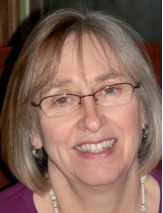Just a note, this is the start of my seventh year posting a monthly art blog. The first one was in February 2009, with scenes inside our Baltimore, Maryland rowhouse. It has been a challenge and a pleasure to show my view of the world in small sketches that have big meaning to me. I enjoy getting feedback from all my viewers.
Here we are outside in the cold at an annual New London event called Dinner With Jack Frost. Local restaurants provide vats of hot food, and volunteers scoop out portions to the brave, bundled townsfolk. I decided to draw with my iPad art app as an experiment. In past years I had used my regular sketch pad, with a little LED light clipped onto it for illumination.
You see the figures grouped around the bonfires, warming up between courses in the meal or just chatting with friends and neighbors. And the white clapboarded New London Inn as a backdrop.
And here is another version I did at home from memory.
Again we spent a few more hours at our little town’s winter carnival the next day. Above is my drawing of the sport called ski joring. Last year we had a video of a skier pulled by a horse. This year I drew a couple of skiers pulled by snowmobiles. There is a horse and its trailer in the background, and some skiers did use a horse. Several skiers managed to successfully grab a ring or more as they whooshed over the jumps and around the snowy town common.
On the snowy town green we met some folks from Wilmot, the next town over, who were displaying their locally made products - ski kites. Kitewing recently established itself here in New Hampshire after its start in Finland. I loved the colors and shapes and how they just fold up like bat wings for easy carrying and storage. Plenty of information exists online if you wish to learn more about this sport.
Ice cutting is still an event on Kezar Lake in Sutton, NH, just a few miles south of our town. We were late arriving, due to a short lived white out (mini blizzard) in our neighborhood, so we missed the actual sawing and lifting out of the large chunks of frozen lake water. They will be stored in a barn at the Muster Field Farm until summer. (It is a living history plein air museum sort of place, well worth a visit.) They will not melt because each cube will be covered and surrounded by sawdust. Yup, sawdust, a natural insulator.
For a fascinating insight into the early 19th Century Boston-based industry of shipping ice all around the world before the advent of artificial refrigeration, see The Frozen Water Trade by Gavin Weightman. It’s available super cheap used at Amazon.
After the drawing of the ice cutting above, we headed to the nearby Vernondale Store in North Sutton, NH. It has recently been carefully renovated, but it intentionally retains an old fashioned atmosphere of the late 1880s.
Last summer we took our grandchildren there for a treat. They each had a fistful of coins to spend at the penny candy counter. And our grandson sprawled on the floor creating castles with the big play bin of construction blocks. The kind with the interlocking bumps on them.
This day we two drank our hot cocoa, and split a muffin.
A few days ago, we heard a musical duo who call themselves the Hardtacks, the name of a subsistence ration (crackers or biscuits) carried by soldiers and sailors in the early days. They were playing folk songs from the era of the American Civil War, the 1860s. They provided great historical insights, interacted enthusiastically with the audience, and eagerly gained further insights from local knowledge shared by audience members.
This blog posting highlights the sense of appreciation for tradition that is life in New Hampshire, and the interest in the new and innovative as well.
_______________
And now back to my summer trip to Los Angeles, California.
This is the Walt Disney Concert Hall and next to it, the Dorothy Chandler Pavilion. The concert hall, designed by Frank Gehry, opened in 2003. It is said to have wonderful acoustics, and I hope to find out for myself one day.
The Los Angeles Union Station, opened in 1939. Besides offering four long distance trains, the station operates four commuter rail lines and two subway lines. The interior is very ornate and beautiful.
And as an example, I drew a colorful column and parts of a tile floor inside Union Station. I think it is obvious that the column is depicted accurately and the floor, well, I went a little wild.
Across the street from Union Station is a replica of the Bell of Dolores, which commemorates Mexico’s independence from Spain in 1821.
The view is from the porch of the Avila Adobe looking down onto Olvera Street, the Mexican market area in Downtown Los Angeles. The pedestrian street, closed to traffic in 1930, is a restored and romanticized version of the original Los Angeles settlement in 1781. It is located near Union Station, and also only a couple of blocks from Chinatown.

















